KOTA KINABALU, Oct 29 — In the state capital, the mention of Kampung Air brings about a wrinkling of the nose, raised eyebrows and knowing smiles.
During the day, the former shoreline of the old city of Jesselton is a bustling hub for local businesses — some more covert than others; budget hotels and rooms for rent by the hour, cheap lodgings and a transient community who populate the place due to its central location and proximity to the local transportation hub and the sea coast.
At night, businesses shutter and the area is a hotbed of literal red-lit lounges and dim-lit cafes, first-floor karaoke joints, hustlers and soliciting in all forms and manners. Sometimes, it’s known derogatorily as “tempat ayam”.
Wanting to clean up its rough image and reputation for the sake of his reggae-themed hostel along Lorong Sentosa, a business owner called in a friend — street art fiend Cracko, also known as Crig Francis — to liven up the building exterior with a wall painting.
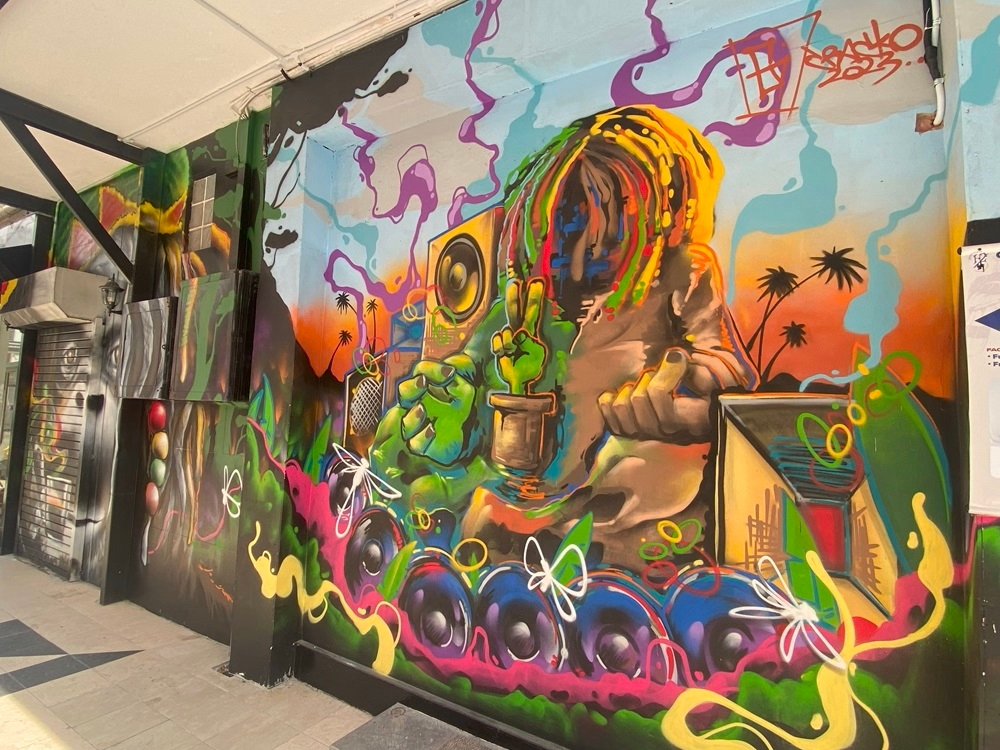
He came up with a piece showing a Rastafarian with artistic speakers, showing the effect music has on soothing nerves and calming its listeners, and on the adjacent wall, an orangutan holding a shot of coffee, a homage to Sabah’s iconic wildlife and H2 hostel’s coffee business using Jamaican coffee beans.
The colourful art piece was such a stark contrast to the mouldy, moss-covered grime of the street that other businesses nearby were intrigued.
Eventually, the interest grew and became a project nicknamed “Street Strokes”. They received support from Nippon Paint which gave them part-sponsored painting material and Kota Kinabalu City Hall was roped in to clean up the area and lend an official authority to engage with business owners and tenants.
Crig called on fellow artists he met at international events, and some online acquaintances in the same industry.
“They just wanted to come and support... for many of them, it was the first time they would visit KK,” he said.
In the end, some 30 artists flew in for a three-day weekend at their own expense: some stayed a little longer at the sponsored hostel, and they worked throughout the weekend to make it in time for a launching ceremony on Sunday.
The artists were free to come up with their own design and space, and were only told not to touch on anything that could be viewed as sensitive.
“I let the artists decide. I respect their artistic freedom to create, with minor rules — that it is public friendly. They got to choose which wall they wanted, brainstorm on what’s suitable for the wall, or they could collaborate with other artists. The process for each is different and interesting — some sketch first, some discuss with others and some just straight up paint,” he said.
Now, a dozen plus colourful artwork — portraits, anime, cartoon-ish, surreal images and fonts in bright colours — beckon visitors to this street previously unexplored by most.
The result is a more vibrant back alley, definitely cleaner, and likely safer Kampung Air. Although there are still glimpses of hustlers and contraband being sold, one would not feel scared to walk in the alley now.
Crig said that the project was tremendous for the artists who felt bonded by the experience.
“All of the artists seem to be in sync with each other, even with the people that lived around here. The only time the scenario changed was when the event ended on Sunday... some of the artists had to go back on Monday morning.
“Suddenly everyone went quiet, like they were sad to leave the new family they had made for that short six days,” he said.
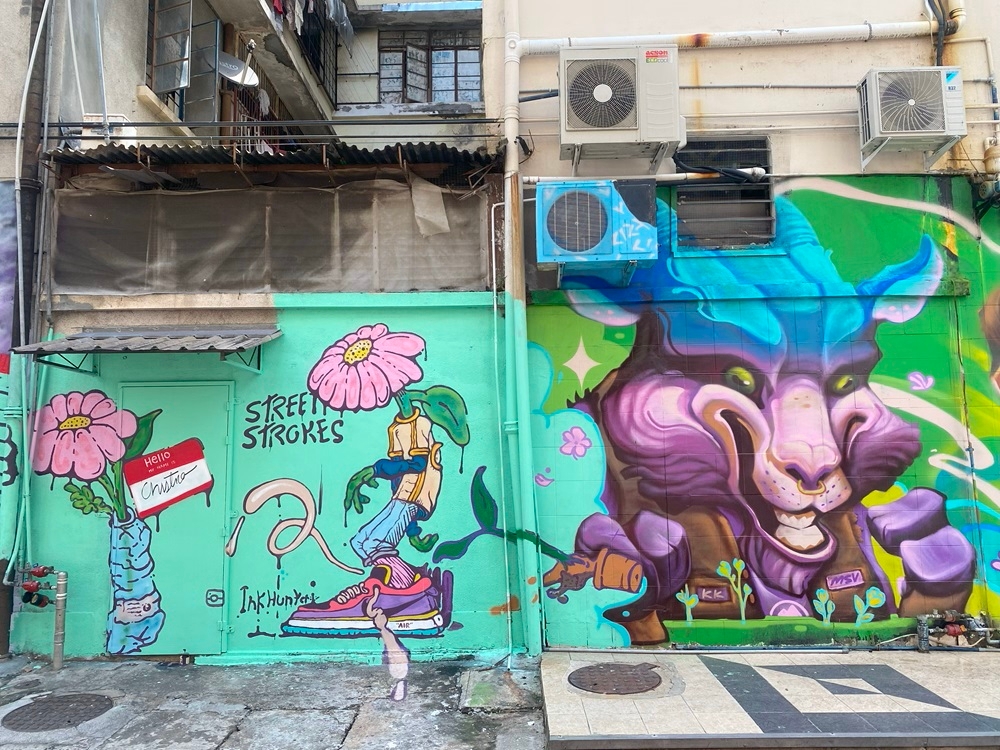
Will there be more?
State Tourism, Culture and Environment minister Datuk Christina Liew was so delighted with the results that she vowed to extend it to other “red” areas in the city.
“The areas are Bandaran Berjaya, Sinsuran, Kampung Air, Asia City and Segama. Not only will we be doing resurfacing and recementing and repair works at the said areas, we will also work with the relevant parties to showcase artworks by local and foreign talents.
“Such street art will make Kota Kinabalu a vibrant and beautiful place to visit. Tourists who come here will be able to have their breakfast at coffee shops here while appreciating beautiful artwork. So I am very happy about this initiative.
“We have already started the related works in Sinsuran,” she said.
Crig, who is still exhausted from the project, however said that news has travelled in the art community globally and he has been getting messages from brands, companies and artists in other countries that want to participate and sponsor a second installation of the project.
He has not committed to a second phase, claiming that artists had volunteered their time, effort and money to do this on their own this time and asking them for a second time was a bit too much.
“Also, this is a community project, so the idea is helping a community. But if it’s just for profit making, the event will become soulless and the main reason for doing it in the first place will be overshadowed by something else... but that’s my own opinion,” he said.
The concept of local street art being used to gentrify an area is not new, and this has been done in other cities, and in Kota Kinabalu as well, where local street artists have done commissioned work for buildings and local businesses.
“It has always had good feedback from the public, and this project was no different. According to the minister, it may be a yearly event,” said Kota Kinabalu City Hall Architecture and Special projects director Sally Edward Ghani.
“This was not on our yearly plans but when it was proposed to the mayor, we saw that it was a very valuable and credible project, and murals were always something we encouraged, so we agreed to collaborate,” she said.
City Hall worked with engaging the building owners and tenants, convincing them about the project and also helping to clean and maintain the area, which included fixing leaky pipes, clearing blocked drains, removing creeper plants and also blocking off vehicle access.
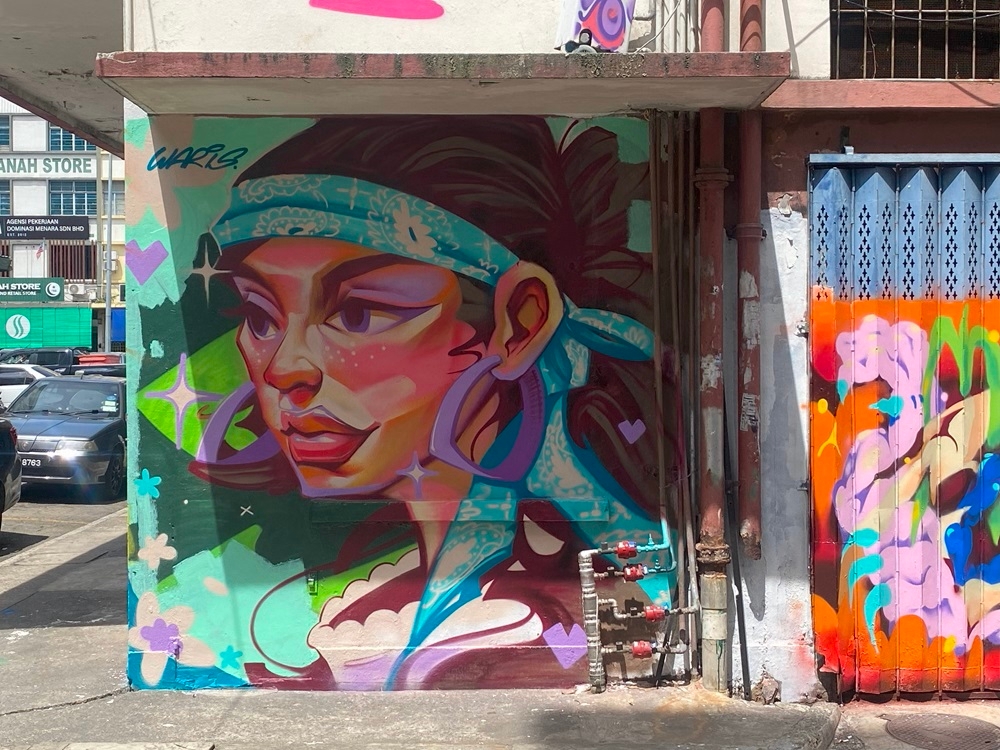
The art and artists
International artists that supported the project were Disek from France, Suiko from Japan, Digital Profet and Ink Hunter from Australia, Alex Knuckle from the USA, Mauy and Waris from Thailand, Trip 63 from the Philippines, Boon Baked from Singapore, Dittymow from the United States, Remon, Baul, Dhal and Kang Sage from Korea, LiarBen and VuiQa from Vietnam and Madnycer, Sketch One, Nerd Ink and Spazy the Architect from Brunei.
From Malaysia, Abdul Rashade, Mile Akmal, Cipan, Andha Ras, Taz Tags, Anddy Romeo, Aks Kwan, Escape VA, Adam Jamal, Snaketwo, Sliz, and Phey are among the local talents involved in the two-day art project.
Colin McKinnon, better known as Digital Profet, a former financial journalist turned bartender turned full-time artist, was very eager to participate in the project despite having only met Crig online in 2018.
“I had left a comment on one of Cracko’s (Crig’s) videos back in 2018 mentioning how much I’d love to visit Malaysia one day. And Cracko with his wonderful memory thought of me for this project. I was surprised to get a message, and felt honoured and a little special he was able to remember me,” said McKinnon.
The Sydney-based artist was quick to agree to the project, and also roped in fellow artist Patrick Hunter, better known as Ink Hunter. He names three big reasons why he was so willing to participate in the project out of his own pocket — travel, the graffiti community, and adventure with his buddy.
“I think it’s important for the growth of the culture, and being a part of that is very special, while the street art scene is worldwide, it is still a relatively small culture.”
Profet said that it was common that such events would liven up any region, but said it was particularly positive here in Kampung Air.
“I understood that the area had a once previous darker history, and what this event has done is radically transform the area by beautifying the streets. It was amazing to see the difference it made.
“I noticed that even by simply walking down the street before the artwork was done, and then doing the same walk afterwards, it felt like a totally new area. The vibe, the feeling the atmosphere had massively shifted, it felt safer, cleaner, friendlier and even felt more welcoming. And all this was done in only two days,” he said.
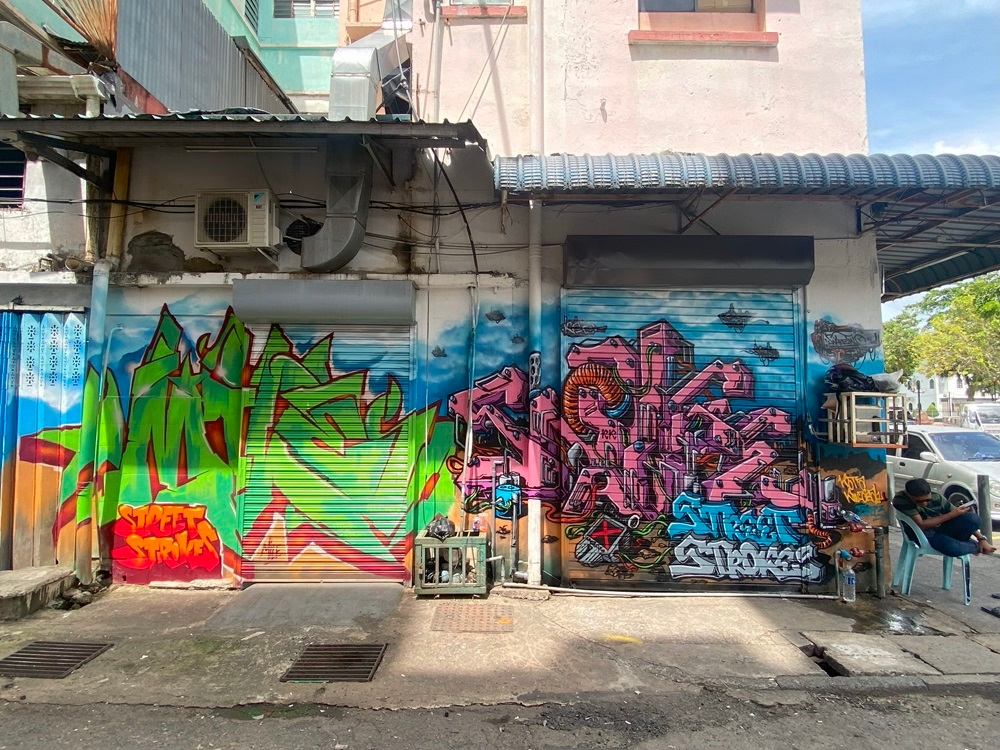
The only challenge in the otherwise very positive experience he said was the rapid changes in weather — humidity and heat, followed by rain.
Profet’s artwork leans towards anime art and culture while Ink Hunter focuses heavily on environmental art. The result was a depiction of a scene from the recent anime movie One Piece where main character Roronoa Zoro battled Bartholomew Kuma.
“It’s a very important scene in the anime series, Zoro is facing an unwinnable battle against Kuma, and we wanted Kuma to represent big corporations and their plastic waste. However due to some of the challenges with the weather, the theme and the wall, we had to simplify it down to a simple scene.
“So in the end I still painted the scene, but with less focus on plastic pollution and more about the scene with Zoro vs Kuma. We left a little bit of plastic in the project though. But maybe not enough to portray the message. Maybe next time!” he said.
Sabah-born art veteran AKS Kwan was also a part of this project.
Having worked with local artists before, and also done murals around the city, he did not hesitate to join this project.
“It was a good opportunity to meet other international artists. We all have our passion for street art in common so despite not everyone speaking the same common language, we still managed to communicate,” said Kwan who said he was not fluent in English.
Kwan’s art piece was a bold graphic piece at the beginning of Lorong Sentosa where all the artists converged.
He had a chat with the business owner whose main trade was lawnmowers, and came up with the idea for his art piece.
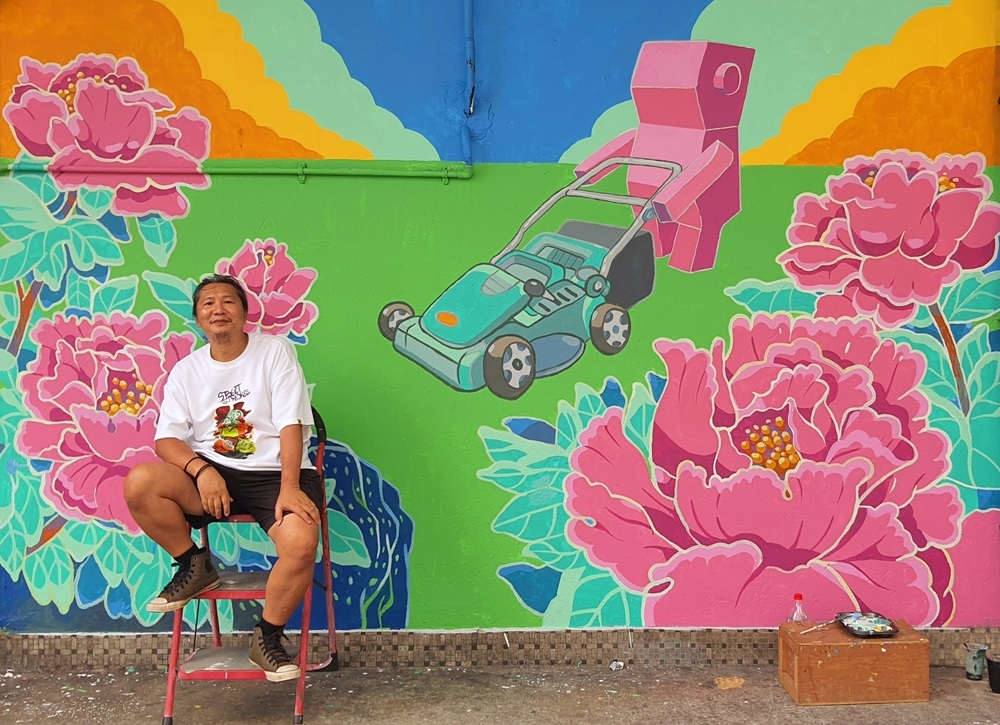
“I didn’t want it to be realistic so I couldn’t just have a human with a lawnmower. That was too generic. So I wanted to have a robot do the grass cutting. Then I added flowers because we want to beautify the city and make KK pretty,” he said.
It took him about four days, a few hours each day, to complete his art which was brushed, and not sprayed.
Kwan said that there were numerous discussions with business owners and the artists over what they wanted to be drawn, but most artists went with their own inspirations and in the end, the people were pleased.
“Some people said it has nothing to do with Sabah, but as artists, and graffiti artists at that, we have to draw from the heart and it is an expression of our thoughts.
“In the future, we could work with a theme, but in this case, we were given a free hand to decide,” he said, adding that there was a good chance there would be a next time, hopefully with payment.




















